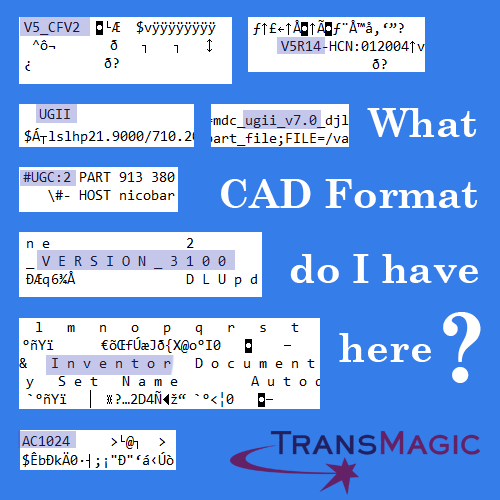 What CAD format, and what version, did that colleague just give you? Most of the time it’s clear what format it is, and most of the time the version doesn’t matter, BUT – sometimes it does.
What CAD format, and what version, did that colleague just give you? Most of the time it’s clear what format it is, and most of the time the version doesn’t matter, BUT – sometimes it does.
This is a repost from a few years back. It has turned out to be one of our most referenced resources, so here it is again!
The following CAD Format Analysis cheat-sheet will allow you to open up CAD files in a text editor like Notepad or Notepad ++ to find out what format they truly are, and in some cases, which version.
I’ve seen cases from some of our customers where CAD files had, for whatever reason, been given the wrong extensions; once we learn the correct format, we rename the file and problem solved. Other times looking at the text inside the file can help us determine if the file is corrupt or if it is a newer version than the customer’s software currently supports.
Here is an index of the most common native CAD formats (CATIA, UG/NX, Pro/E & Creo, SOLIDWORKS, Inventor and Autocad), and how they appear in Notepad:
CATIA
V4 part and assembly files end in *.model. V5 and V6 3D files end in *.CATPart (parts) or *.CATProduct (assemblies).
In Notepad: CATPart V5 part and assembly files will start with V5_CFV2, and you can also tell what release of V5 by searching on V5, for example – V5R20SP6HF16 built on 10-25-2011.11.21
CATProduct files will also have the version at the start of the file: V5_CFV2
For V5 files, if you search on CATSummaryInformation or LastSaveVersion you will find the last saved version, the release, service pack and minimal version to read.
Unigraphics / NX
UG/NX part and assembly files always end in .prt.
In Notepad: UG or NX files will contain and normally start with UGII (that’s UG with two big letter i’s). Search on “ugii” to find the version, for example: ugii_v7.0.
CATIAPro/E or Creo
Pro/E & Creo 3D files always end with .prt (parts) or .asm (assemblies)
In Notepad: The first characters should always be #UGC:
SOLIDWORKS
SOLIDWORKS 3D files end in .sldprt (parts) or .sldasm (assemblies) In Notepad: Search for “V E R S I O N _” (version with spaces between the letters). The version is listed twice in each file. At the end of the version will be four digits. Here is an example: _ D L _ V E R S I O N _ 3 1 0 0. Each set of four digits are tied to a release year:
_7000 = SOLIDWORKS 2014
_3800 = SOLIDWORKS 2008
_3400 = SOLIDWORKS 2007
_3100 = SOLIDWORKS 2006
_2800 = SOLIDWORKS 2005
_2500 = SOLIDWORKS 2004
Inventor
Inventor 3D files always end in .ipt (parts) or iam (assemblies)
In Notepad: Search on I n v e n t o r (“inventor” with spaces between each letter).
AutoCad
AutoCad 3D files always end in DWG or DXF
In Notepad: The first characters should always be AC, followed by a four-digit number. Each four-digit number is tied to a triad of release years.
AC 1027 = AutoCad 2013, 2014, 2015
AC 1024 = AutoCad 2010, 2011, 2012
AC 1021 = AutoCad 2007, 2008, 2009
AC 1018 = AutoCad 2004, 2005, 2006
AC 1015 = AutoCad 2002, 2000i, 2000
Hopefully this info helps you solve some of your own file mysteries.
If you find we’ve missed something and want to share your knowledge, let us know at social@transmagic.com.
